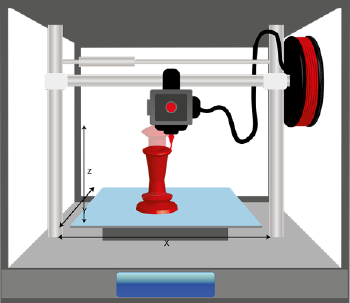| Nov 21, 2021 | |
From science fiction to printing meat - the evolution of 3D Printing continues to astound |
|
| (Nanowerk News) And, get ready for 4D printing, a morphing tech that sounds impossible – much like 3D printing once did | |
| Some may have heard of 3D printing in the 1980s and 1990s, but the majority probably never heard the term until after the turn of the millennium. And even after it was on the radar, most people probably didn't expect much out of it. | |
| Perhaps you saw some of the early attempts at extruding plastic 3D items and if so, you likely didn't think that these unappealing globs would one day evolve into an industry making high-tech products used by aerospace firms or NASA. | |
| It wasn't until roughly 2014 that most hobbyists begin to even be somewhat able to afford a 3D printer, which at that time still cost over US$2,000. In the short time since 2014, the technology has grown, as exponential growth does, exponentially. | |

|
|
| In the 2020s, 3D printers have reached a level of price and quality that allows pretty much anyone to begin using 3D printers for almost anything. You can now buy a relatively good quality 3D printer for less than US$200. These are, of course, entry-level machines but still, the leaps in technology have been astounding. | |
| It probably no longer surprises you to hear that NASA contractors are planning on using 3D printing to create housing modules that may one day be used on the moon or perhaps even on Mars. But it may be somewhat surprising to hear that people are printing meat - both meat from cultured cells, as well as new vegan meat substitutes. | |
| From vegan burgers to plant based steak, ‘new meat’ is being created with 3D printers. The results look set to change diets around the world and possibly be a significant contributor to reducing the effects of climate change by reducing the number of animals raised for food. | |
| Cultured meat is grown in a lab from cells (humanely) taken from real animals, and after the cultured cells grow into a large enough quantity, it’s put into a 3D printer and extruded into a shape that resembles – for example – a chicken nugget. In the case of vegan meat, the latest technology related to flavor and texture is used to print layer after layer of individually unique types of faux, or “alternative” meat. | |
| This means that with 3D printing, you’re able to have the texture of say, beef, and some parts of a printed slab of this meat substitute contain ‘alternative fat’ or ‘alternative muscle’ areas in it. | |

|
|
| This vegan, so-called “new meat,” is the closest science has ever come to recreating meat – and the degree to which it has been successful is surprising. People tasting this ‘new meat’ in Israel have walked away shaking their heads – finding it hard to believe it's not the real deal. | |
| Apparently, there's nothing you can't make with a 3D printer. There are developments related to the technology in almost every area, from shoes uniquely tailored to individual feet, to bespoke bicycle frames, to solutions for life on Mars. This is a technology that literally comes out of a science fiction book. | |
| Murray Leinster’s 1945 short story Things Pass By contains what became a prediction. In the story, Leinster writes, “But this constructor is both efficient and flexible. I feed magnetronic plastics — the stuff they make houses and ships of nowadays — into this moving arm. It makes drawings in the air following drawings it scans with photo-cells. But plastic comes out of the end of the drawing arm and hardens as it comes.” | |
| Sound familiar? Another science fiction description of 3D printing was offered by Raymond F Jones in 1950, but just 21 years later, in 1971 a U.S. patent was granted to Johannes F Gottwald for his ‘Liquid Metal Recorder,’ a forerunner of modern 3D printers. | |
| By the 1980s, inventors in Japan were fabricating three-dimensional plastic models with thermoset polymer. And both American entrepreneurs and French inventors toyed with 3D printing in that decade as well. It wasn't, however, until the first decade of the new century that 3D printing of metal materials became a truly viable option. | |
| And today the tech is in use as anything from a child’s toy to a device used in the aviation industry to create highly complex shapes that wouldn't be feasible with traditional manufacturing methods. 3D printing, which now includes the printing of meat, is science fiction come to life and it's only a matter of time before 4D printing also likewise comes off the page and into the workspace. 4D printing, also known as 4D-bioprinting, would involve the 3D shape being able to morph into different forms and respond to various stimuli. And if that sounds complicated, well, it is. We aren't close to 4D printing as a viable common-use technology at this point. But, remember, that's what they said about 3D printing just a few decades ago. |
Check out our primer on 3D printers for beginners and professionals as well as our overview of the best repositories for free and downloadable 3D printing models and design files.
